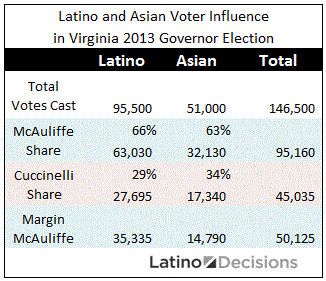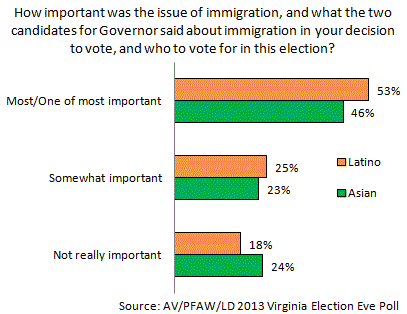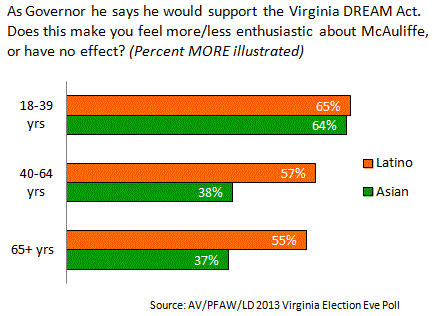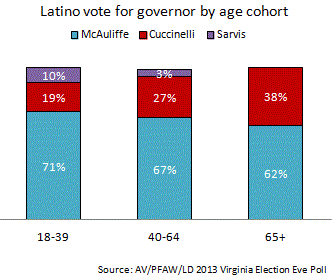Latino Decisions election eve polling shows 66% of Hispanics and 63% of Asian Americans voted for Governor-Elect Terry McAuliffe. More specifically, an estimated 95,500 Hispanic and 51,000 Asian-Americans voted in the Virginia election, meaning that Asian and Hispanic voters provided a combined 95,160 votes for McAuliffe, contributing heavily to his slim 56,494 victory margin.

As provisional ballots continue to be counted, only 164 votes separate apparent Attorney General-Elect Mark Herring and his Republican opponent Mark Obenshain. Latino and Asian-American voters rejected Obenshain as soundly as they did Republican candidate for Governor Ken Cuccinelli. With a formal recount in the AG’s race a near certainty, the balance of power in the Virginia State Senate going into 2014 hangs in the balance. Democrat Ralph Northam’s decisive win over Republican E.W. Jackson in the Lieutenant Governor’s race gives Democrats a tie-breaking vote in the Virginia state senate, where Democrats and Republicans each hold twenty seats. In the legislature’s lower chamber however, Republicans hold a firm super-majority, 67 out of 100 seats. Asian American and Latino voters were dramatically more supportive of Democratic candidates all of these contests.

With a bi-partisan coalition of Delegates gearing up to re-introduce the Virginia DREAM Act early next year in the Republican-led House of Delegates, and McAuliffe’s public expression of support for the bill, partisan control of the Senate may prove a critical lynch-pin to the bill’s success. The vast majority of Virginia voters support such a law, and immigration weighed heavily in vote choices for Latino and Asian voters in particular.

Terry McAuliffe’s support for the Virginia DREAM Act, which he promoted during visits colleges and universities in the state, resonates with Virginia’s younger Asian and Latino electorates. Among Asian and Hispanic voters in the 18 -39 demographic, McAuliffe’s support for a pathway to citizenship and the DREAM Act made 64 percent of young Asian and 65 percent of young Latino voters more enthusiastic about his candidacy, compared to 38 percent of middle-aged Asian and 57 percent of middle-aged Latino voters.

Candidate and policy preferences among Virginia’s young Hispanic and Asian voters signal things to come. The demographic changes evolving in the Virginia electorate make the commonwealth a sort of bellweather for Hispanic influence in elections going forward. Compared to all other states, Virginia has the highest college degree attainment rate among Hispanics; 25% in the state compared to the group national average of 13%. Virginia’s young Hispanic voters were among the most enthusiastic about McAuliffe’s stance on immigration issues. Suggestive evidence that many young Hispanic voters are on college campuses comes by way of their support for Libertarian gubernatorial candidate Robert Sarvis. Consistent with our understanding of college student affinity for Libertarians, 10 percent of Latino voters aged 18-39 voted for Sarvis, his largest pocket of demographic support measured.

Republicans interested in winning statewide office must contend with the demographic and political realities that surfaced in the Virginia election: more Latinos are going to college, Cuccinelli’s showing with young Hispanic and Asian voters was especially disastrous (19% and 20% respectively), and the eligible non-white share of the electorates becomes bigger by the day. Whether the GOP embraces, or once again rejects the Virginia DREAM Act in the upcoming state legislative session will be good indicator of whether the party will seal their fate with Virginia’s fastest-growing segments in the electorate, or whether they can salvage what is left of their vanishing opportunities.
For more information on the AV/PFAW/LD Virginia Election Eve Poll, see the slide deck, topline results and detailed crosstabs .
D. Xavier Medina Vidal is an Assistant Professor of Political Science at Virginia Tech.

